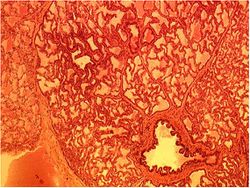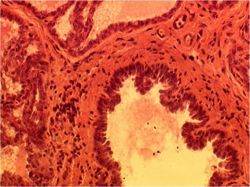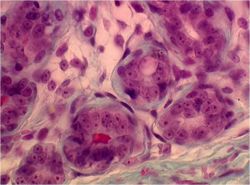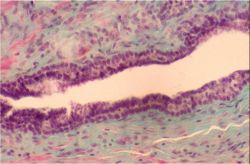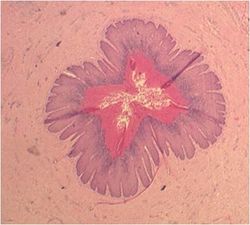Difference between revisions of "Mammary Gland - Anatomy & Physiology"
Fiorecastro (talk | contribs) |
|||
| (77 intermediate revisions by 10 users not shown) | |||
| Line 1: | Line 1: | ||
| − | + | == Introduction == | |
| − | == Introduction | ||
| − | + | The mammary gland is a modified sweat gland that nourishes the young. It consists of the mamma and the teat. Undeveloped in both the male and female at birth, the female mammary gland begins to develop as a secondary sex characteristic at puberty. With the birth of the first young, and first lactation, the mammary gland attains its full size and function. When suckling by the young stops, milk production ceases and the gland regresses. Shortly before the next and subsequent parturitions, the gland is stimulated by hormonal changes to produce milk. | |
| − | |||
| − | + | '''''Development of the Mammary Gland (prenatal mammogenesis)''''' | |
| − | An ectodermal thickening developes along the ventral body wall extending from the thoracic to inguinal region - this is the '''mammary ridge'''. Cells aggregate, multiply and differentiate to form a chain of condensed '''mammary buds'''. Most mammary buds regress | + | * An ectodermal thickening developes along the ventral body wall extending from the thoracic to inguinal region - this is the '''mammary ridge'''. |
| + | * Cells aggregate, multiply and differentiate to form a chain of condensed '''mammary buds'''. | ||
| + | * Most mammary buds regress, those that remain and develop each give rise to a '''mammary gland'''. A mammary gland is the secretory and duct system associated with one teat. | ||
| + | * Mammary buds grow into overlying mesenchyme and '''primary epidermal sprouts''' grow out of the bud apex. The epidermal sprout branches extensively and develops a complete '''duct system'''. | ||
| + | * Mammary adipose tissue is derived from mesoderm. This is required for complete mammary development and is thus absent in the male. As a result, mammary development in the male is halted at the epidermal sprout stage. | ||
| − | + | ---- | |
| − | + | == Structure == | |
| − | + | * '''Mamma (pleural=Mammae) ''': the glandular structure associated with a teat. | |
| + | ** '''Udder''': term designating all the mammae in the ruminant and the mare (sometimes used for the sow). | ||
| + | *** '''Lobes''': the internal compartments of the mamma, separated by adipose tissue. The lobes are divided into '''lobules'''. Lobules consist of connective tissue containing '''alveoli''', which are clusters of milk secreting cells. | ||
| + | *** '''Lactiferous Ducts''': large ducts conveying milk from the alveoli to the milk sinus. The openings of lactiferous ducts convey milk formed in the alveolus to the gland sinus. | ||
| − | + | * '''Milk/Lactiferous Sinus''': milk storage cavity within the teat and glandular body. | |
| + | ** '''Gland Sinus''': part of the milk sinus within the glandular body. | ||
| + | ** '''Teat Sinus''': part of the milk sinus within the teat. | ||
| − | + | * '''Teat''': projecting part of the mammary gland containing part of the milk sinus. | |
| + | ** '''Teat Canal''': canal leading from the teat sinus to the teat opening. | ||
| + | ** '''Teat Opening''': opening of the teat canal. The exit point for milk or entrance point for bacteria into the mammae. | ||
| + | * '''Sphincter''': muscular fibres surrounding the teat opening that prevent milk flow except during suckling or milking. | ||
| − | |||
| − | + | * '''Suspensory Apparatus''': organised into lateral and medial laminae which suspend the mammary gland from the ventral aspect of the trunk by their attachment to the pubic symphysis. | |
| + | ** '''Lateral Lamina''': collagen fibres from the fascia of the pubic symphysis and the edge of the superficial inguinal ring. | ||
| + | ** '''Medial Lamina''': elastic fibres from the tunica flava ventral to the pubic symphysis. Extend between mamillary complexes. | ||
| + | ** '''Intermammary groove''': divides left and right rows of mammary complexes. | ||
| − | + | ---- | |
| − | + | == Blood Supply == | |
| − | + | '''''Arteries''''' | |
| + | * In species with '''inguinal mammary glands''' (cow,ewe,goat,mare), the main blood supply is from the '''external pudendal artery'''. This arises indirectly from the external iliac artery via the femoral artery. The external pudendal artery passes through the inguinal canal. | ||
| + | ** Due to the extensive blood supply in the cow, there is also a small contribution from the '''internal pudendal artery''' which is a branch of the internal iliac atery. Also, the external pudendal artery has a sigmoid flexure to permit the artery to stretch when the udder is full of milk. | ||
| + | * In species which also have '''thoracic mammary glands''' (bitch,queen,sow) blood supply is from the '''internal thoracic artery''' and its branches - cranial and cranial superficial epigastric arteries. | ||
| − | |||
| − | + | '''''Veins''''' | |
| + | * Venous drainage is through '''sattelite veins''', except in ruminants. | ||
| + | * During lactation in ruminants, the external inguinal vein cannot drain the extensive amount of blood present. Thus, the '''cranial and caudal superficial epigastric veins''' anastamose to form the '''milk vein'''. | ||
| + | ** Valves become non-functional to accommodate the increased venous return and allow blood to flow in either direction. This is important, for example if a cow were to lie down, the weight on one side would collapse the thin-walled veins on that side so anastamoses ensure continued venous return. | ||
| + | * '''Milk Well''': where a 'milk vein' travels through the abdominal wall caudal to the costal arch and joins the '''internal thoracic vein'''. | ||
| + | |||
| + | * '''Right and left mammary veins''' anastamose to form a ring around the base of the udder. | ||
| + | ** '''Furstenburg's venous ring''': the venous circle at the junction of the teat and gland sinuses in ruminants. | ||
| − | |||
| − | + | ---- | |
| − | == | + | == Innervation == |
| − | + | * '''Sympathetic''': Innervation to the blood vessels and teat sphincter smooth muscle via the '''genitofemoral nerve'''. | |
| + | * '''Somatic''': Ventral rami of spinal nerves. | ||
| + | ** In the cow, ventral branches of L1 and L2 ('''iliohypogastric and ilioinguinal''') supply the skin of the cranial forequarters. Mammary branches of the '''pudendal nerve''' suply the caudal aspect of the udder (hindquarters). | ||
| − | + | Mammary glands are mainly under the influence of endocrine hormones. | |
| − | |||
| − | + | ---- | |
| − | + | == Lymphatics == | |
| − | + | * '''Inguinal mammary glands''': superficial inguinal lymph node | |
| + | * '''Thoracic mammary glands''': axillary lymph node | ||
| − | |||
| − | + | ''Lymphatic drainage in the cow'' | |
| + | * '''Afferent lymphatic ducts''': pass dorsocaudal to reach the mammary lymph nodes (superficial inguinal). | ||
| + | * '''Mammary (superficial inguinal) lymph nodes''': two nodes at the dorsocaudal side of the udder. Usually a palpable large, kidney-shaped node between the caudal side of the udder base and the thigh. | ||
| + | * '''Efferent lymphatic ducts''': pass into the abdomen through the inguinal canal to empty into the deep inguinal node. | ||
| + | * '''Deep inguinal lymph node''': small, dorsocaudal udder. Too deep to be palpated. | ||
| − | {| | + | ---- |
| − | + | ||
| − | ! Species | + | == Histology == |
| − | ! '''Primates''' | + | |
| − | ! '''Elephant''' | + | * Secretory tissue is arranged into '''lobes''',each consisting of many '''lobules'''. Each lobule contains groups of '''alveoli''' (secretory compound tubuloalveolar cells) surrounded by a network of blood vessels and connective tissue stroma. The alveolar lumen is filled with milk during lactation. |
| − | ! '''Goat and Sheep''' | + | * '''Myoepithelial cells''' lie between alveolar epithelial cells and the basement membrane. These contract under the influence of oxytocin to release milk to the exterior. |
| − | ! '''Guinea Pig''' | + | * Lobes and lobules are drained by lactiferous ducts into the '''gland sinus''', which is continuous with the '''teat sinus'''. Epithelium lining lactiferous ducts and the sinus is two-layered cuboidal. |
| − | ! '''Cow''' | + | * A '''teat canal''' connects the teat sinus to the exterior. The lining is stratified squamous epithelium. Circular smooth muscle in the wall of the canal forms a '''sphincter'''. Between milkings, the narrow lumen of the teat canal is filled with a soft keratin plug to prevent bacteria entering the teat sinus and prevent milk leakage. |
| − | ! '''Mare''' | + | |
| − | ! '''Rat''' | + | |
| − | ! '''Dog''' | + | |
| − | ! '''Sow''' | + | [[Image:Active Mammary Gland.jpg|left|thumb|250px|<small><center> The Active Mammary Gland. Copyright RVC 2008 (Courtesy of Tanya Hopcroft (RVC))</center></small>]] |
| − | ! '''Cat''' | + | |
| − | |- | + | [[Image:Active Mammary Gland high power.jpg|left|thumb|250px|<small><center> The Active Mammary Gland at High Power. Copyright RVC 2008 (Courtesy of Tanya Hopcroft (RVC))</center></small>]] |
| − | | '''Number of | + | |
| − | | 2 | + | [[Image:Mammary Gland myoepithelial cells.jpg|right|thumb|250px|<small><center> Mammary Myoepithelial Cells. Copyright RVC 2008 (Courtesy of Tanya Hopcroft (RVC))</center></small>]] |
| − | | 2 | + | |
| − | | 2 | + | [[Image:Mammary Gland lactiferous duct.jpg|right|thumb|250px|<small><center> Section of the Mammary Gland showing a Lactiferous Duct. Copyright RVC 2008 (Courtesy of Tanya Hopcroft (RVC))</center></small>]] |
| − | | 2 | + | |
| − | | 4 | + | [[Image:Mammary Gland teat canal keratin plug.jpg|right|thumb|250px|<small><center> Cross Section through the Teat Canal of the Mammary Gland showing a Keratin Plug. Copyright RVC 2008 (Courtesy of Tanya Hopcroft (RVC))</center></small>]] |
| − | | 4 (2 teats) | + | |
| − | | ~10 | + | |
| − | | ~10 | + | |
| − | | 8-18 | + | |
| + | |||
| + | |||
| + | |||
| + | |||
| + | |||
| + | |||
| + | |||
| + | |||
| + | |||
| + | |||
| + | |||
| + | |||
| + | |||
| + | |||
| + | |||
| + | |||
| + | |||
| + | |||
| + | |||
| + | |||
| + | |||
| + | |||
| + | |||
| + | |||
| + | |||
| + | |||
| + | |||
| + | |||
| + | |||
| + | |||
| + | |||
| + | |||
| + | |||
| + | |||
| + | |||
| + | |||
| + | |||
| + | |||
| + | |||
| + | |||
| + | |||
| + | |||
| + | |||
| + | |||
| + | |||
| + | |||
| + | |||
| + | |||
| + | |||
| + | |||
| + | |||
| + | |||
| + | |||
| + | |||
| + | |||
| + | |||
| + | |||
| + | |||
| + | |||
| + | |||
| + | |||
| + | |||
| + | |||
| + | |||
| + | |||
| + | |||
| + | |||
| + | |||
| + | |||
| + | |||
| + | |||
| + | |||
| + | |||
| + | |||
| + | |||
| + | |||
| + | |||
| + | |||
| + | |||
| + | |||
| + | |||
| + | |||
| + | |||
| + | |||
| + | ---- | ||
| + | |||
| + | == Species Differences == | ||
| + | |||
| + | '''''Position and Morphology''''' | ||
| + | |||
| + | |||
| + | {| style="width:75%; height:200px" border="1" | ||
| + | |||
| + | !Species | ||
| + | !'''Primates''' | ||
| + | !'''Elephant''' | ||
| + | !'''Goat and Sheep''' | ||
| + | !'''Guinea Pig''' | ||
| + | !'''Cow''' | ||
| + | !'''Mare''' | ||
| + | !'''Rat''' | ||
| + | !'''Dog''' | ||
| + | !'''Sow''' | ||
| + | !'''Cat''' | ||
| + | |- | ||
| + | | '''Number of Mammary Glands''' | ||
| + | | 2 | ||
| + | | 2 | ||
| + | | 2 | ||
| + | | 2 | ||
| + | | 4 | ||
| + | | 4 (2 teats) | ||
| + | | ~10 | ||
| + | | ~10 | ||
| + | | 8-18 | ||
| 8 | | 8 | ||
|- | |- | ||
| − | | '''Position''' | + | | '''Position''' |
| − | | Pectoral | + | | Pectoral |
| − | | Pectoral | + | | Pectoral |
| − | | Inguinal | + | | Inguinal |
| − | | Inguinal | + | | Inguinal |
| − | | Inguinal | + | | Inguinal |
| − | | Inguinal | + | | Inguinal |
| − | | Abdominal,Ventral | + | | Abdominal,Ventral |
| − | | Thoracoabdominoinguinal | + | | Thoracoabdominoinguinal |
| − | | Thoracoabdominoinguinal | + | | Thoracoabdominoinguinal |
| Thoracoabdominal | | Thoracoabdominal | ||
|- | |- | ||
| − | | '''Teat Ducts''' | + | | '''Teat Ducts''' |
| − | | 10-20 | + | | 10-20 |
| − | | Several | + | | Several |
| − | | 1 | + | | 1 |
| − | | 1 | + | | 1 |
| − | | 1 | + | | 1 |
| − | | 2 | + | | 2 |
| − | | 1 | + | | 1 |
| − | | 8-22 | + | | 8-22 |
| − | | 2 | + | | 2 |
| 4-8 | | 4-8 | ||
| + | |- | ||
|} | |} | ||
| − | |||
| − | + | ::[[Lactation - Species Differences Cow - Anatomy & Physiology| Cow]] | |
| − | + | ||
| − | + | ::[[Lactation - Species Differences Small Ruminant - Anatomy & Physiology| Small Ruminant]] | |
| − | + | ||
| − | + | ::[[Lactation - Species Differences Sow - Anatomy & Physiology| Sow]] | |
| − | + | ||
| − | + | ::[[Lactation - Species Differences Mare - Anatomy & Physiology| Mare]] | |
| − | + | ||
| + | ::[[Lactation - Species Differences Carnivore - Anatomy & Physiology| Carnivore]] | ||
| + | |||
| + | '''''Cow''''' | ||
| + | |||
| + | The mammary gland of the cow takes on added significance due to the importance of milk as a human food source. | ||
| + | * Mammary gland comprises four mammary complexes, which are separate units, consolidated in a single mass - the udder. | ||
| + | ** '''Udder''' hangs from the caudal abdomen and pelvis. | ||
| + | *** '''Quarters''': all four parts of the bovine udder, each associated with one teat. All four quarters are completely separated from each other. | ||
| − | + | * Accessory teats, sometimes associated with functional glandular tissue common. | |
| − | + | ** Undesirable, may complicate milking if fused or too close to principle teats. | |
| − | + | * Appearance | |
Revision as of 09:54, 8 July 2008
Introduction
The mammary gland is a modified sweat gland that nourishes the young. It consists of the mamma and the teat. Undeveloped in both the male and female at birth, the female mammary gland begins to develop as a secondary sex characteristic at puberty. With the birth of the first young, and first lactation, the mammary gland attains its full size and function. When suckling by the young stops, milk production ceases and the gland regresses. Shortly before the next and subsequent parturitions, the gland is stimulated by hormonal changes to produce milk.
Development of the Mammary Gland (prenatal mammogenesis)
- An ectodermal thickening developes along the ventral body wall extending from the thoracic to inguinal region - this is the mammary ridge.
- Cells aggregate, multiply and differentiate to form a chain of condensed mammary buds.
- Most mammary buds regress, those that remain and develop each give rise to a mammary gland. A mammary gland is the secretory and duct system associated with one teat.
- Mammary buds grow into overlying mesenchyme and primary epidermal sprouts grow out of the bud apex. The epidermal sprout branches extensively and develops a complete duct system.
- Mammary adipose tissue is derived from mesoderm. This is required for complete mammary development and is thus absent in the male. As a result, mammary development in the male is halted at the epidermal sprout stage.
Structure
- Mamma (pleural=Mammae) : the glandular structure associated with a teat.
- Udder: term designating all the mammae in the ruminant and the mare (sometimes used for the sow).
- Lobes: the internal compartments of the mamma, separated by adipose tissue. The lobes are divided into lobules. Lobules consist of connective tissue containing alveoli, which are clusters of milk secreting cells.
- Lactiferous Ducts: large ducts conveying milk from the alveoli to the milk sinus. The openings of lactiferous ducts convey milk formed in the alveolus to the gland sinus.
- Udder: term designating all the mammae in the ruminant and the mare (sometimes used for the sow).
- Milk/Lactiferous Sinus: milk storage cavity within the teat and glandular body.
- Gland Sinus: part of the milk sinus within the glandular body.
- Teat Sinus: part of the milk sinus within the teat.
- Teat: projecting part of the mammary gland containing part of the milk sinus.
- Teat Canal: canal leading from the teat sinus to the teat opening.
- Teat Opening: opening of the teat canal. The exit point for milk or entrance point for bacteria into the mammae.
- Sphincter: muscular fibres surrounding the teat opening that prevent milk flow except during suckling or milking.
- Suspensory Apparatus: organised into lateral and medial laminae which suspend the mammary gland from the ventral aspect of the trunk by their attachment to the pubic symphysis.
- Lateral Lamina: collagen fibres from the fascia of the pubic symphysis and the edge of the superficial inguinal ring.
- Medial Lamina: elastic fibres from the tunica flava ventral to the pubic symphysis. Extend between mamillary complexes.
- Intermammary groove: divides left and right rows of mammary complexes.
Blood Supply
Arteries
- In species with inguinal mammary glands (cow,ewe,goat,mare), the main blood supply is from the external pudendal artery. This arises indirectly from the external iliac artery via the femoral artery. The external pudendal artery passes through the inguinal canal.
- Due to the extensive blood supply in the cow, there is also a small contribution from the internal pudendal artery which is a branch of the internal iliac atery. Also, the external pudendal artery has a sigmoid flexure to permit the artery to stretch when the udder is full of milk.
- In species which also have thoracic mammary glands (bitch,queen,sow) blood supply is from the internal thoracic artery and its branches - cranial and cranial superficial epigastric arteries.
Veins
- Venous drainage is through sattelite veins, except in ruminants.
- During lactation in ruminants, the external inguinal vein cannot drain the extensive amount of blood present. Thus, the cranial and caudal superficial epigastric veins anastamose to form the milk vein.
- Valves become non-functional to accommodate the increased venous return and allow blood to flow in either direction. This is important, for example if a cow were to lie down, the weight on one side would collapse the thin-walled veins on that side so anastamoses ensure continued venous return.
- Milk Well: where a 'milk vein' travels through the abdominal wall caudal to the costal arch and joins the internal thoracic vein.
- Right and left mammary veins anastamose to form a ring around the base of the udder.
- Furstenburg's venous ring: the venous circle at the junction of the teat and gland sinuses in ruminants.
Innervation
- Sympathetic: Innervation to the blood vessels and teat sphincter smooth muscle via the genitofemoral nerve.
- Somatic: Ventral rami of spinal nerves.
- In the cow, ventral branches of L1 and L2 (iliohypogastric and ilioinguinal) supply the skin of the cranial forequarters. Mammary branches of the pudendal nerve suply the caudal aspect of the udder (hindquarters).
Mammary glands are mainly under the influence of endocrine hormones.
Lymphatics
- Inguinal mammary glands: superficial inguinal lymph node
- Thoracic mammary glands: axillary lymph node
Lymphatic drainage in the cow
- Afferent lymphatic ducts: pass dorsocaudal to reach the mammary lymph nodes (superficial inguinal).
- Mammary (superficial inguinal) lymph nodes: two nodes at the dorsocaudal side of the udder. Usually a palpable large, kidney-shaped node between the caudal side of the udder base and the thigh.
- Efferent lymphatic ducts: pass into the abdomen through the inguinal canal to empty into the deep inguinal node.
- Deep inguinal lymph node: small, dorsocaudal udder. Too deep to be palpated.
Histology
- Secretory tissue is arranged into lobes,each consisting of many lobules. Each lobule contains groups of alveoli (secretory compound tubuloalveolar cells) surrounded by a network of blood vessels and connective tissue stroma. The alveolar lumen is filled with milk during lactation.
- Myoepithelial cells lie between alveolar epithelial cells and the basement membrane. These contract under the influence of oxytocin to release milk to the exterior.
- Lobes and lobules are drained by lactiferous ducts into the gland sinus, which is continuous with the teat sinus. Epithelium lining lactiferous ducts and the sinus is two-layered cuboidal.
- A teat canal connects the teat sinus to the exterior. The lining is stratified squamous epithelium. Circular smooth muscle in the wall of the canal forms a sphincter. Between milkings, the narrow lumen of the teat canal is filled with a soft keratin plug to prevent bacteria entering the teat sinus and prevent milk leakage.
Species Differences
Position and Morphology
| Species | Primates | Elephant | Goat and Sheep | Guinea Pig | Cow | Mare | Rat | Dog | Sow | Cat |
|---|---|---|---|---|---|---|---|---|---|---|
| Number of Mammary Glands | 2 | 2 | 2 | 2 | 4 | 4 (2 teats) | ~10 | ~10 | 8-18 | 8 |
| Position | Pectoral | Pectoral | Inguinal | Inguinal | Inguinal | Inguinal | Abdominal,Ventral | Thoracoabdominoinguinal | Thoracoabdominoinguinal | Thoracoabdominal |
| Teat Ducts | 10-20 | Several | 1 | 1 | 1 | 2 | 1 | 8-22 | 2 | 4-8 |
Cow
The mammary gland of the cow takes on added significance due to the importance of milk as a human food source.
- Mammary gland comprises four mammary complexes, which are separate units, consolidated in a single mass - the udder.
- Udder hangs from the caudal abdomen and pelvis.
- Quarters: all four parts of the bovine udder, each associated with one teat. All four quarters are completely separated from each other.
- Udder hangs from the caudal abdomen and pelvis.
- Accessory teats, sometimes associated with functional glandular tissue common.
- Undesirable, may complicate milking if fused or too close to principle teats.
- Appearance
